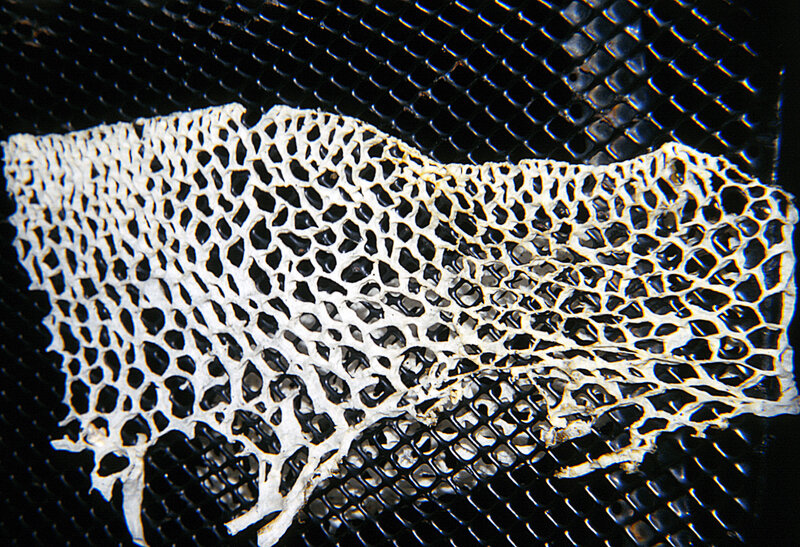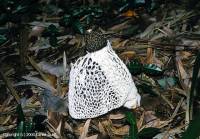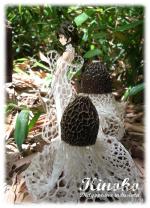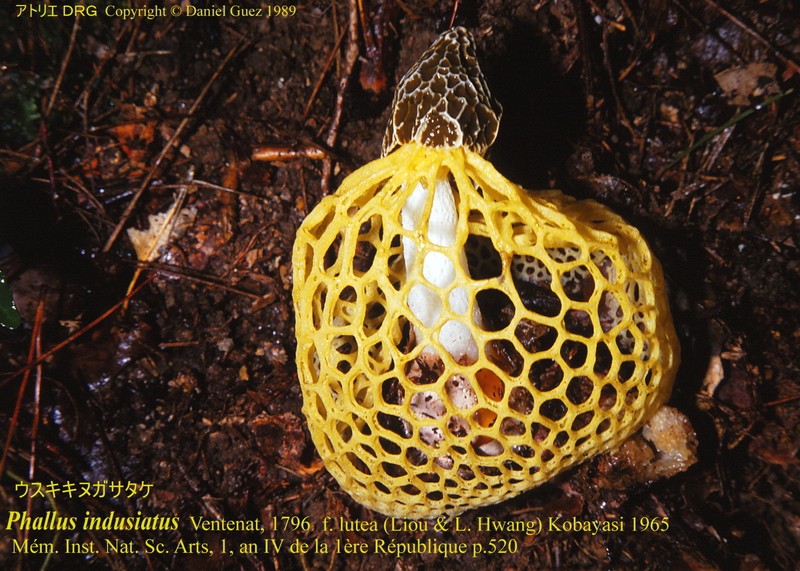ウスキキヌガサタケPhallus indusiatus Ventenat 1796 ex Persoon forma lutea Kobayasi
Phallus indusiatus Ventenat 1796 ex Persoon forma lutea Kobayasi
[= Dictyophora indusiata (Vent.: Pers.) Fischer fo. lutea Kobayasi ]
Phallus luteus (Liou & L. Hwang) T. Kasuya, comb. nov. Figures 1-2
- Basidiomycota / Gasteromycetes / Phallales / Phallaceae
- Synonymes :
Dictyophora indusiata (Vent.) Desv. 1809 ;
Hymenophallus indusiatus (Vent.) Nees 1817
- Oeuf plus ou moins sphérique, 3-4-(6) cm de diamètre, blanc ou rarement se teintant de brun rougeâtre ou de mauve au frottement, muni d'un cordon mycélien et d'une touffe de rhizoïdes à la base. L'éclosion commence généralement dans les premières heures de la journée par la rupture du péridium sous la poussée du carpophore en expansion rapide (2-4 heures selon la température ambiante en zone pénétropicale).
- Stipe cylindrique, 15-20-(25) cm x 1,5-3 cm, blanc, poreux et tubulaire, de consistance spongieuse, fait de 2 ou 3 couches de cellules aérées, aussi léger que du polystyrène. Sa vitesse de croissance est de 1-2 mm par minute selon la température et humidité ambiante.
- Thermophile et tropical, Afrique, Asie, Amérique du Sud, Australie, en juin et en automne au Japon, peu commun à rare, isolé ou en troupe, sous bambous ou rudéral.
- Comestibilité sans intérêt
- Références bibliographiques CD 1747 ; IH1 909 ; IOH p. 522-523
- Commentaires : Consommé en Chine. Frustrés de ne pas comprendre l'utilité de cette indusie spectaculaire, certains ont supposé qu'elle servirait à rendre le champignon plus visible aux insectes en mal d'odorat, ou faciliter l'escalade des rampants vers la zone fertile : voilà un "fun guy" qui ajoute du "fun", comme les "Jungle Gyms" des jardins d'enfants!
La forme lutea se distingue du type par son indusie d'un beau jaune d’œuf, la volve rougissante et le mycélium violaçant.
学名の意味: 服を着たファルス茸(または網を着た)の黄色品種
和名: ウスキキヌガサタケ (スッポンタケ科、腹菌亜綱)
採取場所: 広島県賀茂郡河内町、広葉樹林地上
採集年月日:1989年7月17日
スッポンタケの仲間で白いレ-スの網を持った基準種のキヌガサタケは、熱帯に発生する珍しいキノコであるが、網が完全に発達したものは少ない。ところが熱帯には属さない日本のキヌガサタケは、規則的な細かな網目と柄全体を覆って地面に付くほどの長さの完全な網を形成する例外的なものである。この写真のウスキキヌガサタケは、キヌガサタケの1品種(黄色型)であるが、前種よりさらに稀なキノコで、世界中で広島、宮崎、徳島、京都以外にはその発生は知られていない。梅雨期と秋の年2回、雑木林内に発生。幼菌はスッポンタケの他種同様に白い卵型である。熟すると3層の殻 皮が早朝に裂開し、柄をスッポリ包むほどの黄色のレ-スのマントを編み広げながら、一分間に約3mmの速さで伸張し、高さ15~18cm、柄部は2~3cmの太さとなる。傘の表面は円錐形で黄色の網 目状隆起を有し、ネバネバした基本体はハエを引きつける。ツボにつながる菌糸紐は空気に触れると 白色から淡紫色に変わる。
このキノコを見つけたとき、明るい道路から入った森は一瞬立ち止まるほど暗く、しばらく目を凝らしていると、草むらのあちこちにポッ、ポッ、ポッと明りがともっているかのような印象であり。それはロココ風ミニランプとでも呼びたいようなかわいいものであった。
迎図 陀仁得 & 利恵
Phallus luteus (Liou & L. Hwang) T. Kasuya, comb. nov. Figures 1-2
Literature : Kasuya, T. 2008. Phallus luteus comb. nov., a new taxonomic treatment of a tropical phalloid fungus. Mycotaxon. 106:7-13
Remarks (internal) : Morphological characters of the specimens examined agree well with the previous descriptions of the present fungus (Liou & Hwang 1936, Kobayasi 1938, 1942, 1965a, b, Ito 1959, Yoshimi & Hongo 1989, Guzmán et al. 1990, Liu et al. 2005, Yamamoto & Yamamoto 2007). This fungus was defined by a yellowish reticulate pileus, yellow indusium, and pale pink to reddish purple peridium with rhizomorphs. These morphological characteristics suggest its placement in Phallus subgen. Phallus sect. Flavophallus Kreisel (Kreisel 1996). It clearly differs from P. indusiatus (? D. indusiata) in its yellow pileus and indusium, and pale pink to reddish purple peridium with rhizomorphs. Therefore, D. indusiata f. lutea is accepted as an independent species, P. luteus. The recently described Indian fungus, P. indusiatus f. citrinus (Das et al. 2007), is morphologically very similar to P. luteus in having yellow pileus and indusium, vinaceous to dark vinaceous peridium. Original description and color figures of P. indusiatus f. citrinus (Das et al. 2007) represent well the present fungus in both macroscopic and microscopic features. Therefore, I conclude they are identical. Phallus luteus having priority over P. indusiatus f. citrinus, the name should be adopted as the correct one for the present fungus (Art. 11.4, ICBN Vienna Code).
There are seven other known Phallus species in section Flavophallus (Kreisel 1996). Among them, P. callichrous (Möller) Lloyd, P. multicolor (Berk. & Broome) Cooke, and P. cinnabarinus (W.S. Lee) Kreisel are morphologically similar to P. luteus in possession of indusium and purplish eggs. However, its whitish indusium clearly distinguishes P. callichrous (Kobayasi 1942). Phallus multicolor is also distinguishable from P. luteus by its orange, pink to red pileus and indusium and slightly longer (3.5-4.5 × 1.5-2 µm; Cunningham 1944) basidiospores. Further, P. cinnabarinus is clearly different from P. luteus because the former has a cinnabar-red to brilliant red pileus and indusium (Lee 1957). The four other species in sect. Flavophallus – P. flavocostatus Kreisel, P. tenuis (E. Fisch.) Kuntze, P. sulphureus Lohwag and P. formosanus Kobayasi – differ from P. luteus in their white to yellowish peridium, yellow to pink receptacles and the absence of an indusium (Kobayasi 1938, Li et al. 2004, 2005).
Phallus tenuissimus T. H. Li et al., recently described from China (Li et al. 2005), also has a yellow, reticulate pileus and a pale yellow receptacle with a white to yellowish peridium. Although P. tenuissimus is probably placed in section Flavophallus, it is clearly distinguished from P. luteus by its peridium colour and the absence of an indusium.
Description type : Non-original description
Description : Phallus luteus (Liou & L. Hwang) T. Kasuya, comb. nov. Figures 1-2
MycoBank MB 512085
Basionym: Dictyophora lutea Liou & L. Hwang, Chinese J. Bot. 1: 89 (1936).
? Dictyophora indusiata f. lutea (Liou & L. Hwang) Kobayasi, J. Jap. Bot. 40: 179 (1965).
= Dictyophora indusiata f. aurantiaca Kobayasi, Nova Flora Japonica 2: 83 (1938).
= Phallus industiatus f. citrinus K. Das, S.K. Singh & Calonge, Bol. Soc. Micol. Madrid 31: 136 (2007).
Egg subglobose to ovoid, 30-55 × 30-60 mm, hypogeous or subhypogeous when young, later epigeal, pale pink to reddish purple, with long, branched, pink to reddish purple rhizomorphs up to 150 mm long. Peridium threelayered: exoperidium papery, persistent, pale pink to reddish purple, surface smooth but slightly gyrose near the base; mesoperidium gelatinous, viscous, thick, hyaline, pale pink to reddish purple; endoperidium membranous to slightly fibrous, very thin, evanescent, whitish, covering upper surface of gleba.
Mature basidiomata 85-240 mm tall, composed of a receptacle, a pileus covered with a gleba and an indusium. Receptacle forming a pseudostipe, 70-220 mm tall, 15-25 mm diam. at apex, cylindrical, subfusoid or tapering toward the base, spongy, hollow, surface reticulate with polygonal depressions, white, cream to pale yellow, with pink to reddish purple peridium at the base.
Pileus conical to slightly campanulate, apex somewhat conical, truncate with a whitish disc at the centre, 25-40 mm tall, 26-38 mm diam. at lower margin, surface strongly reticulate, pale yellow to yellowish orange, covered with gleba; meshes deep, polygonal to rounded, 2-5 mm diam. Gleba mucous, olivaceous brown to greenish black, with foetid odor. Indusium 60-160 mm long, papery, fragile when dried, margin entire; dissetiment narrow, yellow to yellowish orange; meshes polygonal to rounded, 2-7 mm diam. Exoperidium divided into two layers; outer one up to 250-500 µm thick, composed of filamentous hyphae, 5-15 µm diam., elongate, interwoven, septate, thick-walled, hyaline, pale brown to purplish brown, with clamp-connections; inner one up to 100-250 µm thick, composed of filamentous hyphae 2-4 µm diam., elongate, subparallel, gelatinous, septate, thick-walled, hyaline, with clamp-connections.
Receptacle consists of pseudoparenchymatous cells 5-43 µm diam., globose to subglobose, thin-walled. Basidia not observed. Basidiospores broadly ellipsoid to cylindric, 3-4 × 1.5-2 µm, smooth, hyaline, thin-walled, often truncate at base.
Habitat – On the ground or humus in evergreen woods and bamboo groves, especially under Cryptomeria japonica, Phyllostachys pubescens, Quercus spp. or Castanopsis spp.
Distribution – Japan, China, Korea, India, tropical America (Mexico).
Japanese name – Usuki-kinugasa-také (Kobayasi 1938).
|
Phallus indusiatus Ventenat 1798, Mém. Inst. nat. Sci. Arts 1: 520
|
||
|
Satyre voilé, Tisseur de soie (キヌガサタケ)
|
||

On a beau savoir que tous les Phallus ont une indusie, elle est pratiquement invisible, réduite à quelques millimètres, elle ne dépasse guère du chapeau. Au contraire du sous-genre Dictyophora, ou elle enferme tout le champignon dans une cage grillagée. La structure fine et légère comme de la dentelle est entièrement démontable, comme une lampe de chevet (ampoule, pied et abat-jour ! ) ...
 La croissance du champignon est rapide à partir de l'éclosion de l'oeuf. Deux heures suffisent le plus souvent à l'achèvement du tricotage de l'indusie, plus d'un millimètre par minute, que l'on peut détecter à l'oeil nu.
La croissance du champignon est rapide à partir de l'éclosion de l'oeuf. Deux heures suffisent le plus souvent à l'achèvement du tricotage de l'indusie, plus d'un millimètre par minute, que l'on peut détecter à l'oeil nu.
 rubrovolvata .... son indusie blanche dans le panier noir de la bicyclette, la ressemblance est saisissante :)
rubrovolvata .... son indusie blanche dans le panier noir de la bicyclette, la ressemblance est saisissante :)
|
Phallus voilé à bulbe rouge (アカダマキヌガサタケ)
|
||
 |
 |
 |
 |
 |
 |
 |
 |
- Basidiomycota / Gasteromycetes / Phallales / Phallaceae
- Synonymes Dictyophora rubrovolvata M. Zang, D.G. Ji & X.X. Liu 1976
- Carpophore Blanc
- Stipe Couleur : Blanc, Brun, Mauve, Rouge
- Odeur Désagréable
- Ecologie: Dans les forêts de bambous, jardins, décombres, plus ou moins rudéral.
- Comestibilité Sans intérêt






/http%3A%2F%2Fstorage.canalblog.com%2F97%2F31%2F1309869%2F102336709_o.jpg)
/http%3A%2F%2Fstorage.canalblog.com%2F16%2F46%2F1309869%2F114015576_o.jpg)
/http%3A%2F%2Fstorage.canalblog.com%2F20%2F73%2F1309869%2F99963673_o.jpg)
/https%3A%2F%2Fassets.over-blog.com%2Ft%2Fcedistic%2Fcamera.png)